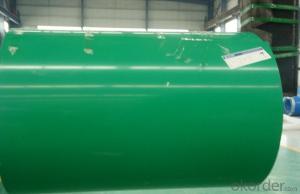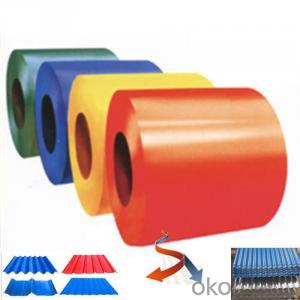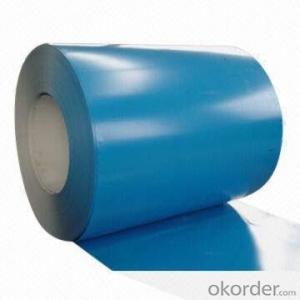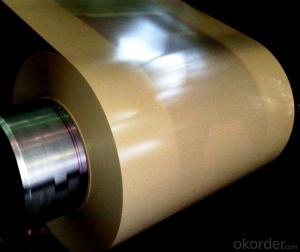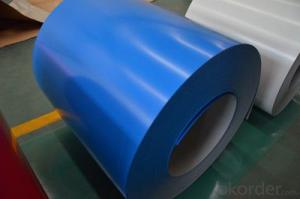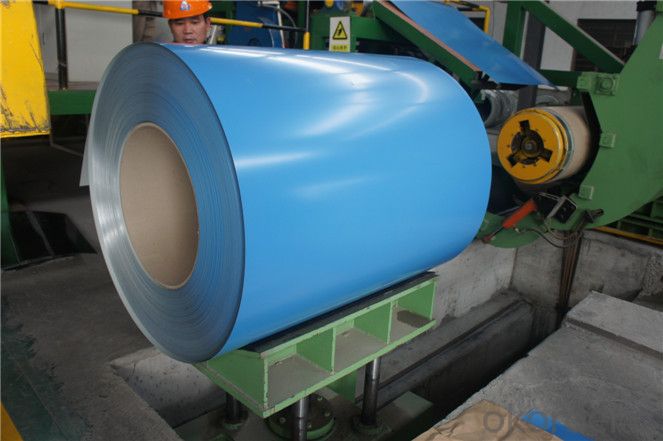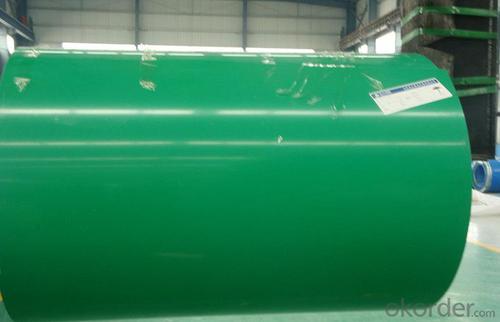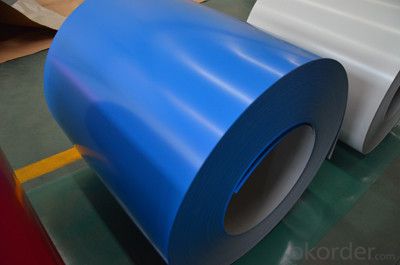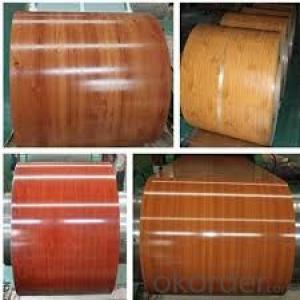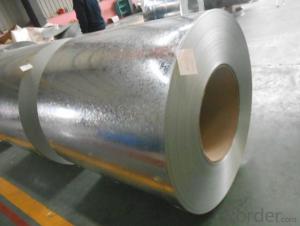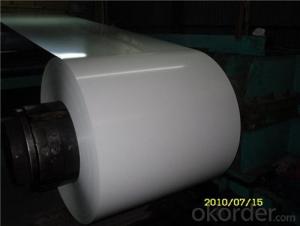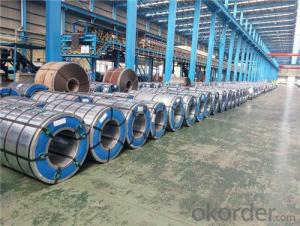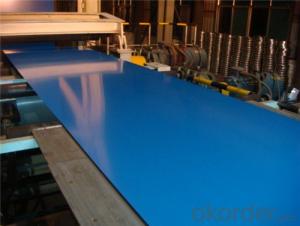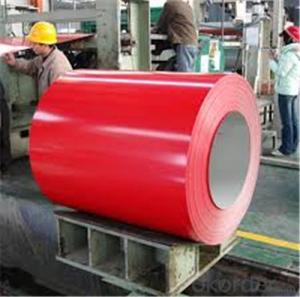BMP Z25 PPGI Rolled Steel Coil for Roofing Constrution
- Loading Port:
- Shanghai
- Payment Terms:
- TT OR LC
- Min Order Qty:
- 100 m.t.
- Supply Capability:
- 30000 m.t./month
OKorder Service Pledge
OKorder Financial Service
You Might Also Like
Structure of BMP Z25 PPGI Rolled Steel Coil for Roofing Constrution

Description of BMP Z25 PPGI Rolled Steel Coil for Roofing Constrution
Cold Rolled Steel is pre-treated before being cold rolled with a process known as pickling, which uses strong acids to remove scale and other impurities.The Cold Rolled Steel is then passed through rollers to reduce its thickness. Most cold rolling takes place in multiple passes and as the size of the Cold Rolled Steel is further reduced, its strength and hardness both increase, but its ductility decreases.After cold rolling, heating the metal up in a process known as annealing can restore some of its ductility.
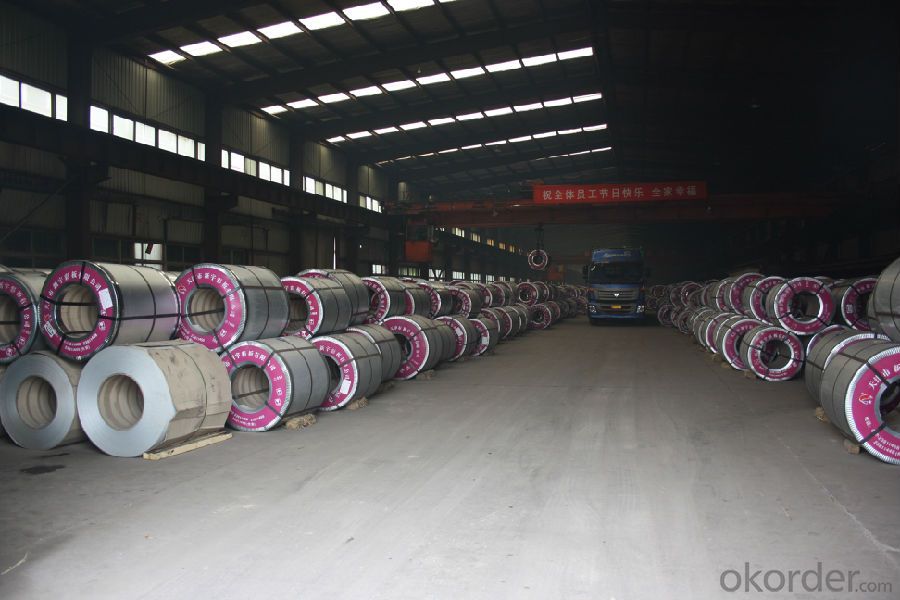
Advantage of BMP Z25 PPGI Rolled Steel Coil for Roofing Constrution
1. more than 30 years experiences in steel business
2. good quality products from all China national mills
3. competitive price in China
4. meet your needs via reprocessing
5. excellent service and most rapid response
6. short delivery time to meet all the international market demand
Applications of BMP Z25 PPGI Rolled Steel Coil for Roofing Constrution
If the yield point is not pronounced, the value applies to R p0.2 ; if the yield point is pronounced, the value applies to R el . When the thickness is less than or equal to 0.7 mm and greater than 0.5 mm, the minimum value for elongation is reduced by 2 units. For a thickness less than or equal to 0.5 mm, the minimum value is reduced by 4 units.it is ideal for a wide range of applications, such as pre-engineered buildings, architectural panels, roofing, siding, cladding, and many other building components.and also used back plate of appliance; wide range of construction, furniture industry, transportation industry, etc.
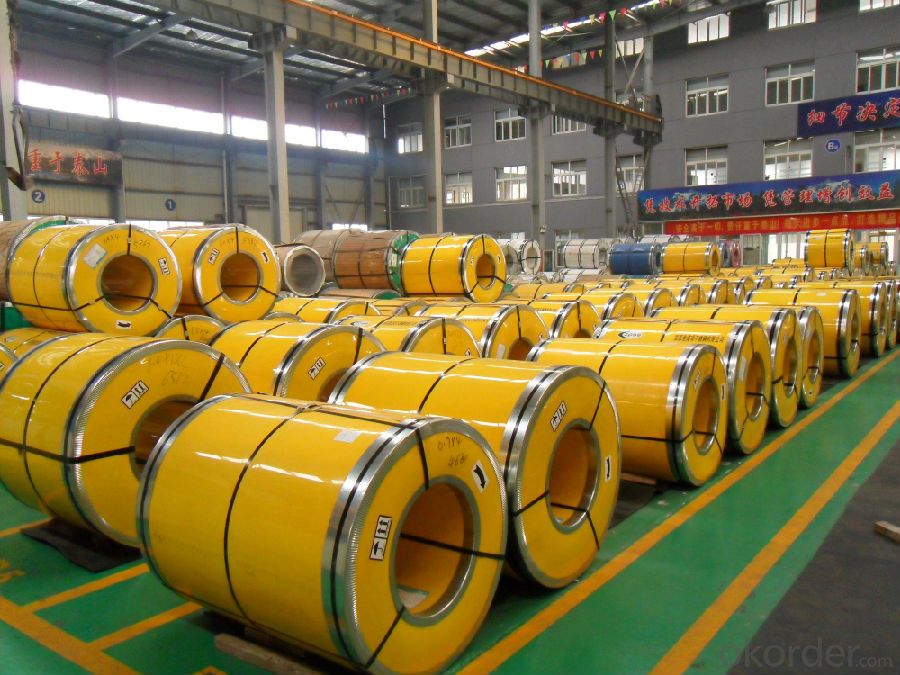
Specifications of BMP Z25 PPGI Rolled Steel Coil for Roofing Constrution
Standard | ASTM A653, JIS G3302, GB/T3830-2006 |
Grade | SGCC, DX51D, A653, SGCH, Q235B |
Thickness | 0.125-1.0mm |
Width | 600-1250mm |
Base metal | Galvanized steel coils, Alumzinc steel coils, color coated steel coils |
Zinc coating | 40-275g/M2 |
Coil ID | 508mm/610mm |
Packing | Standard seaworthy export packing: 3 layers of packing, inside is kraft paper, water plastic film is in the middle and outside GI steel sheet to be covered by steel strips with lock, with inner coil sleeve. |
Delivery | Within 10-30days after signing contract |
Price | FOB& CNF& CIF price |
Payment terms | TT or LC, Western Union |
Capacity | 5000MT per month |
MOQ | 100MT |
Usage | construction, the manufacturing of cars, ships, containers and household electric appliances,other industries usage. |
FAQ of BMP Z25 PPGI Rolled Steel Coil for Roofing Constrution
We have organized several common questions for our clients,may help you sincerely:
1.Are you a factory or a trading company?
CNBM is a trading company in this industry over 30 years, located in Beijing
2.Are the products tested before shipping??
Yes, all of our PPGI and GI was qualified before shipping. We test every batch every day.
3.Why choose us?
ISO system
SGS and BV audited company.
Industry experience over 10 years.
Management systems-internal software
Finished product inventory-more than 500 tons.
Raw material inventory -over 800 mertic tons.
Shipment of goods -more than 30 countries worldwide.
We have the most convenient transport and prompt delivery.
We offer competitive price with best service.
We have high technical production line with top quality products.
We have win high reputation based on best quality products.
- Q: I need to identify a metal. It is rusty so I suspect it is either iron or steel. Since they both have similar densities and are magnetic, how do I tell the difference betweeen steel and iron?
- Iron and Steel Manufacture, technology related to the production of iron and its alloys, particularly those containing a small percentage of carbon. The differences between the various types of iron and steel are sometimes confusing because of the nomenclature used. Steel in general is an alloy of iron and carbon, often with an admixture of other elements. Some alloys that are commercially called irons contain more carbon than commercial steels. Open-hearth iron and wrought iron contain only a few hundredths of 1 percent of carbon. Steels of various types contain from 0.04 percent to 2.25 percent of carbon. Cast iron, malleable cast iron, and pig iron contain amounts of carbon varying from 2 to 4 percent. A special form of malleable iron, containing virtually no carbon, is known as white-heart malleable iron. A special group of iron alloys, known as ferroalloys, is used in the manufacture of iron and steel alloys; they contain from 20 to 80 percent of an alloying element, such as manganese, silicon, or chromium.
- Q: What are the environmental benefits of using steel coils?
- There are several environmental benefits associated with using steel coils. Firstly, steel is a highly recyclable material. Steel coils can be easily recycled and repurposed into new steel products, reducing the need for mining and extraction of raw materials. Recycling steel also requires less energy compared to producing it from scratch, resulting in lower greenhouse gas emissions and a smaller carbon footprint. Additionally, steel is known for its durability and longevity. When used in construction or manufacturing applications, steel coils can last for decades without losing their structural integrity. This reduces the need for frequent replacements, which in turn reduces the consumption of resources and energy required for production. Furthermore, steel is highly resistant to corrosion and weathering, making it a suitable choice for outdoor applications. This resistance to decay means that steel coils can withstand harsh environmental conditions and maintain their functionality for extended periods. This reduces waste generation and the associated environmental impacts of replacing damaged or deteriorated materials. Lastly, steel is a versatile material that can be used in a wide range of industries and applications. Its versatility allows for efficient use of resources, as steel coils can be easily adapted and customized to meet specific project requirements. This versatility also enables the use of steel in sustainable building designs, such as energy-efficient structures or green buildings that incorporate renewable energy systems. In conclusion, the environmental benefits of using steel coils include their recyclability, durability, resistance to corrosion, and versatility. By choosing steel coils for various applications, we can contribute to resource conservation, reduced carbon emissions, and a more sustainable future.
- Q: what is the difference between stainless steel 304 (AISI 304) and stainless steel 310 (AISI 310) COR-TEN A
- Weathering steel will rust, but the rust will be adherant and not flake off and be replaced by new rust. Therefore once it rusts it will pretty much stop rusting any more. One (severe) down side is that anything around it will be streaked with rust stains and it will look awful. Some bozo with the Texas Department of Transportation designed a number of freeway interchange overpasses here in Houston using Cor-Ten steel and all of the concrete supports are streaked with red rust stains and it looks like hell. Cameron built an office building here in Houston with a Cor-Ten facade and it is streaked with rust too. They should have gone ahead and spent the money and painted them, but they didn't.
- Q: How do steel coils contribute to the energy efficiency of buildings?
- Steel coils contribute to the energy efficiency of buildings in several ways. Firstly, steel coils are often used in the construction of roofs and walls, providing a durable and well-insulated structure that helps to minimize heat transfer and reduce energy loss. Additionally, steel coils can be coated with reflective materials, such as cool roof coatings, which help to reflect the sun's heat and reduce the cooling load on the building. Lastly, steel coils are also commonly used in the manufacturing of HVAC systems, ensuring efficient heating and cooling operations, further enhancing the energy efficiency of buildings.
- Q: How are steel coils coated for color and aesthetics?
- Steel coils are coated for color and aesthetics through a process called coil coating. This involves applying a layer of paint or coating onto the steel coil surfaces, which is then cured and bonded to create a uniform and durable finish. This coating process not only enhances the appearance of the steel coils but also provides protection against corrosion and other environmental factors, making them suitable for various applications in industries such as construction and automotive.
- Q: I have a Victorinox Pioneer, and I recently filed a little metal off the blade for some jimping. Is the already stainless steel blade still stainless?
- Stainless steel knives, sinks, etc.may or may not be stainless steel all the way through. The question arises however, what Quality of stainless steel? For steel to be highly rust resistant, a minimum of 12% chromium must be added to the iron along with carbon (for hardness). Good food-grade stainless also is likely to contain nickel, niobium, molybdenum, and/or titanium. Victorinox has a pretty good reputation to protect so I would expect your blade is still stainless. Some good old American brand names however have been sold to marketers who outsource manufacturing to China and scrimp on the chromium and nickle content in their stainless products. That is why you can spend $50 at Lowes for a stainless steel barbeque tool set of fork, tongs, lifter etc and find them spotted with rust within a few months.
- Q: How are steel coils used in the manufacturing of shipbuilding?
- Steel coils are used in shipbuilding for several purposes. They are primarily used to fabricate the hull and structural components of ships. Steel coils are cut, shaped, and welded to form various ship sections, such as the hull plates, bulkheads, and decks. These coils provide the necessary strength, durability, and corrosion resistance required for marine applications. Additionally, steel coils are also used to manufacture other shipbuilding components like piping, machinery, and equipment, ensuring the overall integrity and functionality of the vessel.
- Q: I am looking for steel. I need a lot.
- Ryerson-Tull sells all sorts of steel. As does Liebovitch. I'm not what the phone numbers are to these places, but I'm sure you could find them on the internet.
- Q: We are going to build a house with a steel frame.Someone told me today that these houses have problems with humidity.Is that true?Please tell me all you know..
- the building I work in is steel framed, no humidity problems. I can't believe that steel frame anything causes humidity problems. I would ask for an explanation from whom ever told you this. One thing is cell phones, radios etc. have bad reception due to all the interference.
- Q: What are the common defects found in uncoiled steel coils?
- Some common defects found in uncoiled steel coils include edge waves, center buckles, coil breaks, surface defects such as scratches or dents, and variations in thickness or width.
Send your message to us
BMP Z25 PPGI Rolled Steel Coil for Roofing Constrution
- Loading Port:
- Shanghai
- Payment Terms:
- TT OR LC
- Min Order Qty:
- 100 m.t.
- Supply Capability:
- 30000 m.t./month
OKorder Service Pledge
OKorder Financial Service
Similar products
Hot products
Hot Searches
Related keywords

